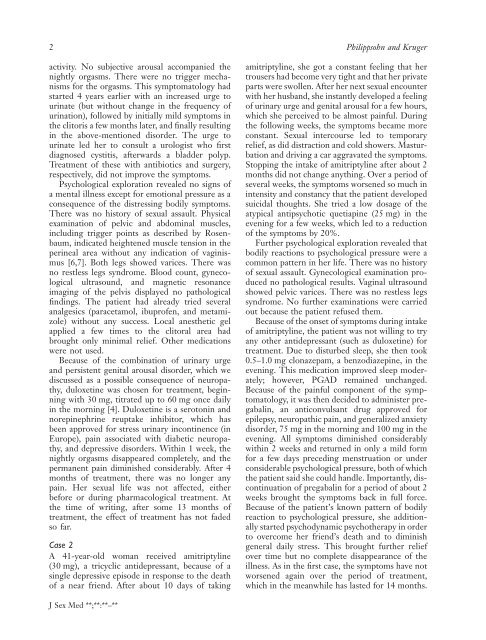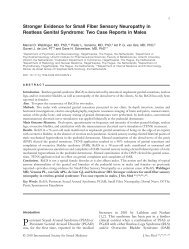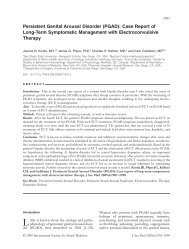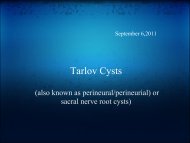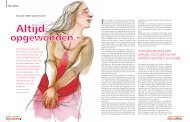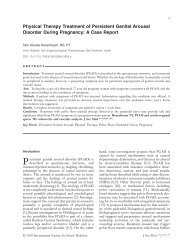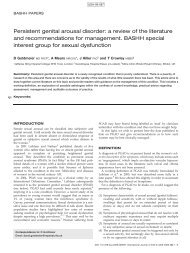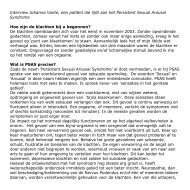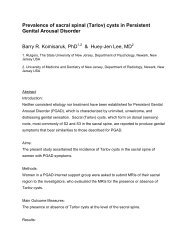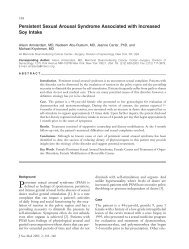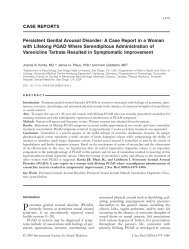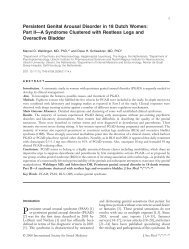Persistent Genital Arousal Disorder - (Genital) Arousal Syndrome
Persistent Genital Arousal Disorder - (Genital) Arousal Syndrome
Persistent Genital Arousal Disorder - (Genital) Arousal Syndrome
You also want an ePaper? Increase the reach of your titles
YUMPU automatically turns print PDFs into web optimized ePapers that Google loves.
2 Philippsohn and Krugeractivity. No subjective arousal accompanied thenightly orgasms. There were no trigger mechanismsfor the orgasms. This symptomatology hadstarted 4 years earlier with an increased urge tourinate (but without change in the frequency ofurination), followed by initially mild symptoms inthe clitoris a few months later, and finally resultingin the above-mentioned disorder. The urge tourinate led her to consult a urologist who firstdiagnosed cystitis, afterwards a bladder polyp.Treatment of these with antibiotics and surgery,respectively, did not improve the symptoms.Psychological exploration revealed no signs ofa mental illness except for emotional pressure as aconsequence of the distressing bodily symptoms.There was no history of sexual assault. Physicalexamination of pelvic and abdominal muscles,including trigger points as described by Rosenbaum,indicated heightened muscle tension in theperineal area without any indication of vaginismus[6,7]. Both legs showed varices. There wasno restless legs syndrome. Blood count, gynecologicalultrasound, and magnetic resonanceimaging of the pelvis displayed no pathologicalfindings. The patient had already tried severalanalgesics (paracetamol, ibuprofen, and metamizole)without any success. Local anesthetic gelapplied a few times to the clitoral area hadbrought only minimal relief. Other medicationswere not used.Because of the combination of urinary urgeand persistent genital arousal disorder, which wediscussed as a possible consequence of neuropathy,duloxetine was chosen for treatment, beginningwith 30 mg, titrated up to 60 mg once dailyin the morning [4]. Duloxetine is a serotonin andnorepinephrine reuptake inhibitor, which hasbeen approved for stress urinary incontinence (inEurope), pain associated with diabetic neuropathy,and depressive disorders. Within 1 week, thenightly orgasms disappeared completely, and thepermanent pain diminished considerably. After 4months of treatment, there was no longer anypain. Her sexual life was not affected, eitherbefore or during pharmacological treatment. Atthe time of writing, after some 13 months oftreatment, the effect of treatment has not fadedso far.Case 2A 41-year-old woman received amitriptyline(30 mg), a tricyclic antidepressant, because of asingle depressive episode in response to the deathof a near friend. After about 10 days of takingamitriptyline, she got a constant feeling that hertrousers had become very tight and that her privateparts were swollen. After her next sexual encounterwith her husband, she instantly developed a feelingof urinary urge and genital arousal for a few hours,which she perceived to be almost painful. Duringthe following weeks, the symptoms became moreconstant. Sexual intercourse led to temporaryrelief, as did distraction and cold showers. Masturbationand driving a car aggravated the symptoms.Stopping the intake of amitriptyline after about 2months did not change anything. Over a period ofseveral weeks, the symptoms worsened so much inintensity and constancy that the patient developedsuicidal thoughts. She tried a low dosage of theatypical antipsychotic quetiapine (25 mg) in theevening for a few weeks, which led to a reductionof the symptoms by 20%.Further psychological exploration revealed thatbodily reactions to psychological pressure were acommon pattern in her life. There was no historyof sexual assault. Gynecological examination producedno pathological results. Vaginal ultrasoundshowed pelvic varices. There was no restless legssyndrome. No further examinations were carriedout because the patient refused them.Because of the onset of symptoms during intakeof amitriptyline, the patient was not willing to tryany other antidepressant (such as duloxetine) fortreatment. Due to disturbed sleep, she then took0.5–1.0 mg clonazepam, a benzodiazepine, in theevening. This medication improved sleep moderately;however, PGAD remained unchanged.Because of the painful component of the symptomatology,it was then decided to administer pregabalin,an anticonvulsant drug approved forepilepsy, neuropathic pain, and generalized anxietydisorder, 75 mg in the morning and 100 mg in theevening. All symptoms diminished considerablywithin 2 weeks and returned in only a mild formfor a few days preceding menstruation or underconsiderable psychological pressure, both of whichthe patient said she could handle. Importantly, discontinuationof pregabalin for a period of about 2weeks brought the symptoms back in full force.Because of the patient’s known pattern of bodilyreaction to psychological pressure, she additionallystarted psychodynamic psychotherapy in orderto overcome her friend’s death and to diminishgeneral daily stress. This brought further reliefover time but no complete disappearance of theillness. As in the first case, the symptoms have notworsened again over the period of treatment,which in the meanwhile has lasted for 14 months.J Sex Med **;**:**–**


